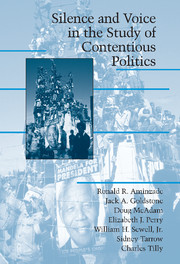Book contents
- Frontmatter
- Contents
- Preface
- 1 SILENCE AND VOICE IN THE STUDY OF CONTENTIOUS POLITICS: INTRODUCTION
- 2 EMOTIONS AND CONTENTIOUS POLITICS
- 3 SPACE IN CONTENTIOUS POLITICS
- 4 IT'S ABOUT TIME: TEMPORALITY IN THE STUDY OF SOCIAL MOVEMENTS AND REVOLUTIONS
- 5 LEADERSHIP DYNAMICS AND DYNAMICS OF CONTENTION
- 6 THE SACRED, RELIGIOUS, AND SECULAR IN CONTENTIOUS POLITICS: BLURRING BOUNDARIES
- 7 THREAT (AND OPPORTUNITY): POPULAR ACTION AND STATE RESPONSE IN THE DYNAMICS OF CONTENTIOUS ACTION
- 8 CONTENTION IN DEMOGRAPHIC AND LIFE-COURSE CONTEXT
- 9 HARMONIZING THE VOICES: THEMATIC CONTINUITY ACROSS THE CHAPTERS
- References
- Index
6 - THE SACRED, RELIGIOUS, AND SECULAR IN CONTENTIOUS POLITICS: BLURRING BOUNDARIES
Published online by Cambridge University Press: 05 June 2012
- Frontmatter
- Contents
- Preface
- 1 SILENCE AND VOICE IN THE STUDY OF CONTENTIOUS POLITICS: INTRODUCTION
- 2 EMOTIONS AND CONTENTIOUS POLITICS
- 3 SPACE IN CONTENTIOUS POLITICS
- 4 IT'S ABOUT TIME: TEMPORALITY IN THE STUDY OF SOCIAL MOVEMENTS AND REVOLUTIONS
- 5 LEADERSHIP DYNAMICS AND DYNAMICS OF CONTENTION
- 6 THE SACRED, RELIGIOUS, AND SECULAR IN CONTENTIOUS POLITICS: BLURRING BOUNDARIES
- 7 THREAT (AND OPPORTUNITY): POPULAR ACTION AND STATE RESPONSE IN THE DYNAMICS OF CONTENTIOUS ACTION
- 8 CONTENTION IN DEMOGRAPHIC AND LIFE-COURSE CONTEXT
- 9 HARMONIZING THE VOICES: THEMATIC CONTINUITY ACROSS THE CHAPTERS
- References
- Index
Summary
Introduction: Religion and Politics
Theories of social movements have been built, for the most part, from studies of western democracies in which the differentiation of secular and religious institutions and norms is unusually pronounced. The result of focusing on such secularized societies has been a tendency to see religions as furnishing social movements with organizational (and occasionally ideological) resources – but little more. Thus scholars have often emphasized ways in which churches serve as mobilizing networks, and have sometimes also noted the importance of religious beliefs and symbols as a source of collective action framing. Less frequently, however, have they ventured beyond a purely instrumentalist perspective to explore the expressive dimensions of religious conviction in processes of contention.
In this chapter our focus is on cases drawn from Chinese and African societies that have diverged from the secularized path of change in the West. China (in both its communist and precommunist incarnations) has not institutionalized the sort of church-state separation and attendant freedoms of religion that are taken as hallmarks of liberal democratic polities. In Africa, even where institutional differentiation and religious freedom are evident, popular beliefs about other-worldly entities and sacred legitimations of secular authority continue to inform routine and nonroutine politics. The reasons for these distinctive patterns of church-state relations and belief systems need not concern us here, but one result is that the intersection of religion and politics assumes quite different – and in some respects more transparent – consequences in our cases than may be evident in many western democracies.
- Type
- Chapter
- Information
- Silence and Voice in the Study of Contentious Politics , pp. 155 - 178Publisher: Cambridge University PressPrint publication year: 2001
- 16
- Cited by

